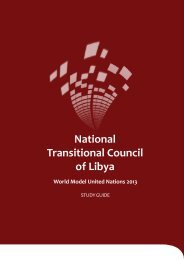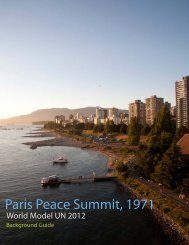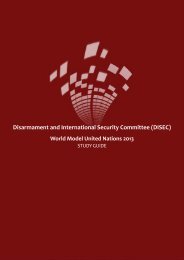Social, Humanitarian and Cultural Committee (SOCHUM)
Social, Humanitarian and Cultural Committee (SOCHUM)
Social, Humanitarian and Cultural Committee (SOCHUM)
You also want an ePaper? Increase the reach of your titles
YUMPU automatically turns print PDFs into web optimized ePapers that Google loves.
on the Rights of indigenous Peoples, in order to<br />
ensure that certain populations are not excluded. in its<br />
l<strong>and</strong>mark convention on the topic, the International<br />
Labour Organization defines “indigenous peoples”<br />
as those that are descended from a population that<br />
inhabited a given region at the time of conquest or<br />
colonization. 114 Others define the term more broadly<br />
to include any marginalized population that has strong<br />
ties to native l<strong>and</strong>s, practices subsistence agriculture,<br />
<strong>and</strong>/or possesses a unique culture, language, or social<br />
<strong>and</strong> political structure. Not all minority populations<br />
are indigenous, but most indigenous peoples are a<br />
minority in their respective states.<br />
Causes of Minority Poverty<br />
In their book on minority development in China,<br />
Bhalla <strong>and</strong> Qiu provide a relatively uncontroversial<br />
definition of poverty: “a social phenomenon<br />
under which the st<strong>and</strong>ard of living of individuals<br />
<strong>and</strong> households in a community or a country is<br />
persistently below a certain level required physically<br />
for sustaining human life according to some accepted<br />
norms.” 115 More important than a compact definition<br />
are the indicators of poverty, which include low<br />
income <strong>and</strong> consumption levels; the inability to<br />
receive adequate shelter, education, <strong>and</strong> heath care;<br />
<strong>and</strong> lack of access to employment opportunities. 116<br />
A distinction must be made, however, between<br />
absolute <strong>and</strong> relative poverty. Absolute poverty is a<br />
circumstance in which an individual does not have<br />
access to a basic level of resources necessary to live.<br />
Indicators of absolute poverty include starvation<br />
<strong>and</strong> malnutrition; poor health due to diet <strong>and</strong> lack<br />
of hygiene; <strong>and</strong> no attainment of any education. 117<br />
Relative poverty is a situation in which an individual<br />
has the resources to survive but not in a way that<br />
matches the st<strong>and</strong>ards of society in terms of diet,<br />
education, <strong>and</strong> employment. It is vital to utilize these<br />
different definitions of poverty when discussing <strong>and</strong><br />
attempting to solve indigenous impoverishment in<br />
various regions. In much of the developed world for<br />
example, essentially none of the population lives in<br />
absolute poverty; these countries must make efforts<br />
to bring its citizens out of relative poverty. In the<br />
developing world, a significant percentage of the<br />
population lives in absolute poverty, so the primary<br />
focus there should be to increase access to basic<br />
nutrition, employment, <strong>and</strong> shelter. 118<br />
Liberalization of Trade<br />
One of the most notable causes of the<br />
impoverishment of indigenous peoples over the past<br />
decades has been the push toward the liberalization<br />
of international trade. This problem encompasses two<br />
trends that are intrinsically intertwined: the expansion<br />
of transnational corporations into indigenous l<strong>and</strong>s<br />
<strong>and</strong> the declining viability of local indigenous means<br />
of subsistence. For centuries, indigenous populations<br />
have utilized this l<strong>and</strong> for their own (primarily<br />
agricultural) practices with little-to-no interference<br />
from outside entities. Recently, however, laws have<br />
permitted transitional corporations, often with the<br />
blessing of national governments, to enter indigenous<br />
l<strong>and</strong>s with the purpose of extracting natural resources<br />
like oil, gas, <strong>and</strong> minerals. With the development<br />
of large-scale resource extraction equipment, local<br />
agricultural techniques are no longer viable, leaving<br />
these indigenous communities with little food <strong>and</strong> no<br />
chance for employment.<br />
The liberalization of international trade has<br />
negatively impacted the prosperity of indigenous<br />
populations through the direct competition of largescale<br />
agricultural production. The primary driver of<br />
this change was the 1995 World Trade Organization<br />
Agreement on Agriculture (WtO Agreement on<br />
Agriculture). While the details are not particularly<br />
relevant to this discussion, one of the goals of the<br />
WtO Agreement on Agriculture was to encourage<br />
export competition <strong>and</strong> import liberalization through<br />
reductions of import <strong>and</strong> export tariffs. 119 the World<br />
32<br />
Melbourne Host Directorate PTY LTD | Office of Media <strong>and</strong> Design

















